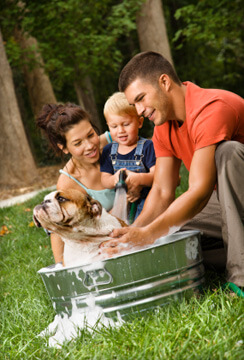|
 No
one likes a bad hair day … and that includes your dog. Just like with humans,
the skin is the largest organ of a dog’s body. Every day, their skin and
coats are exposed to UV rays, pollution, infectious agents, drying heat
or wind. Because it can contribute to a dog’s overall health, grooming should
be an essential part of companion animal care. However, despite your best
intentions, it’s not unusual for grooming habits to hit a glitch. Or two.
Or three! While bathing a dog, I think all of us have experienced getting
wetter than your dog, being interrupted by phone calls, or, worst of all,
a sudsy canine tearing off, leaving a wet, sudsy trail behind him. As a
veterinarian with a good deal of grooming experience, I can tell you that
planning ahead can reduce unwanted problems and stress, so here are a handful
of my best tips. No
one likes a bad hair day … and that includes your dog. Just like with humans,
the skin is the largest organ of a dog’s body. Every day, their skin and
coats are exposed to UV rays, pollution, infectious agents, drying heat
or wind. Because it can contribute to a dog’s overall health, grooming should
be an essential part of companion animal care. However, despite your best
intentions, it’s not unusual for grooming habits to hit a glitch. Or two.
Or three! While bathing a dog, I think all of us have experienced getting
wetter than your dog, being interrupted by phone calls, or, worst of all,
a sudsy canine tearing off, leaving a wet, sudsy trail behind him. As a
veterinarian with a good deal of grooming experience, I can tell you that
planning ahead can reduce unwanted problems and stress, so here are a handful
of my best tips.
BEFORE THE GROOMING SESSION
Unfortunately, bathing can be stressful for some dogs, as some just tolerate
it better than others. For those pups who are particularly skiddish, consider
brewing some chamomile tea to calm your dog. Thirty minutes before you bathe,
give your dog a cooled cup of chamomile tea with honey, followed by a dog
treat that’s rich in carbohydrates, like our
Antioxidant Health Bars. The carbohydrates will help deliver the calming
tea straight to your dog’s brain. Better yet, you can both sit down with
some tea and play soothing music, to set a calming tone for your upcoming
grooming session. You can also give your dog tea during the grooming session.
As we’ve already mentioned, just make sure the tea has cooled off (no hotter
than room temperature). More... |